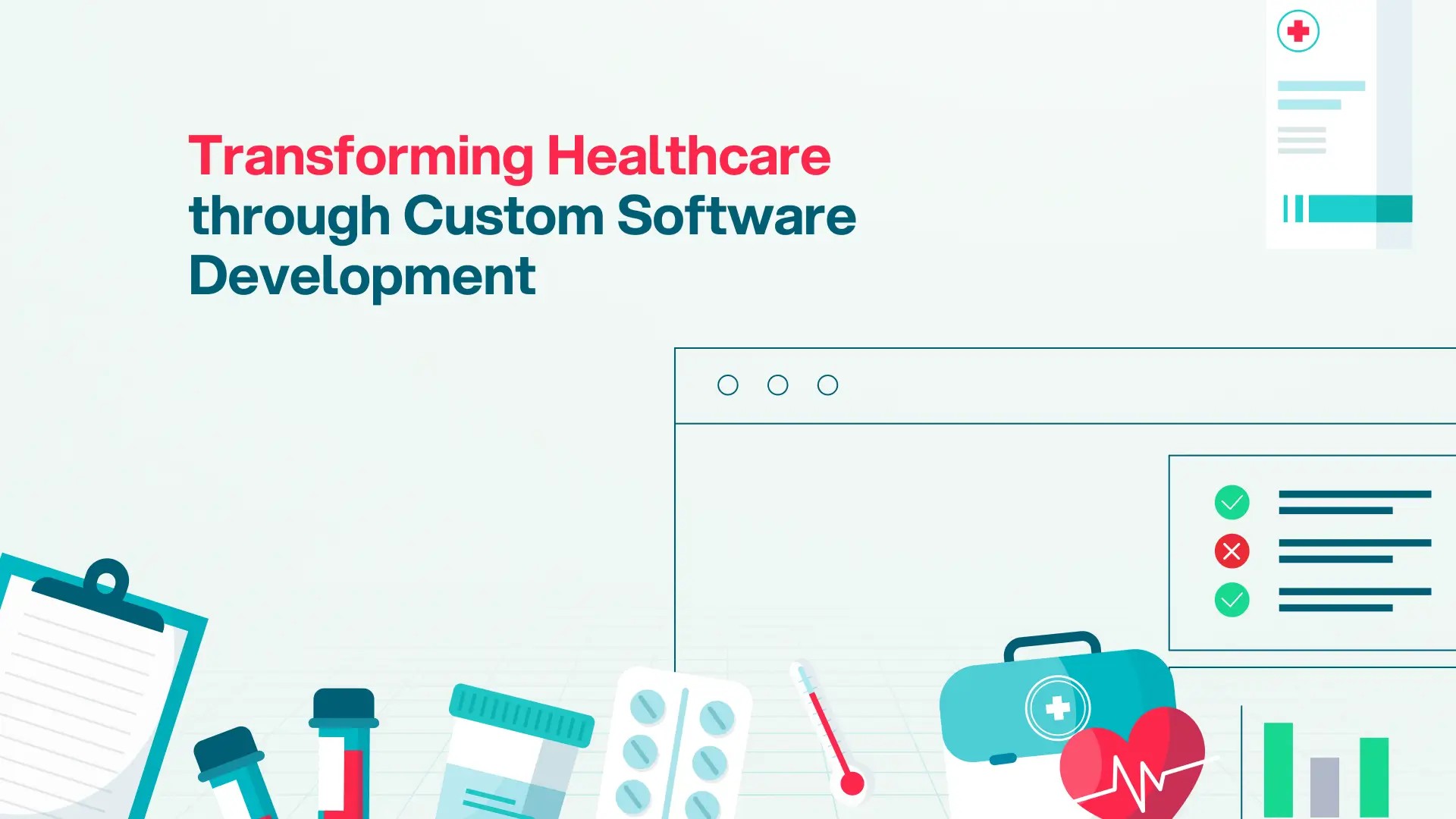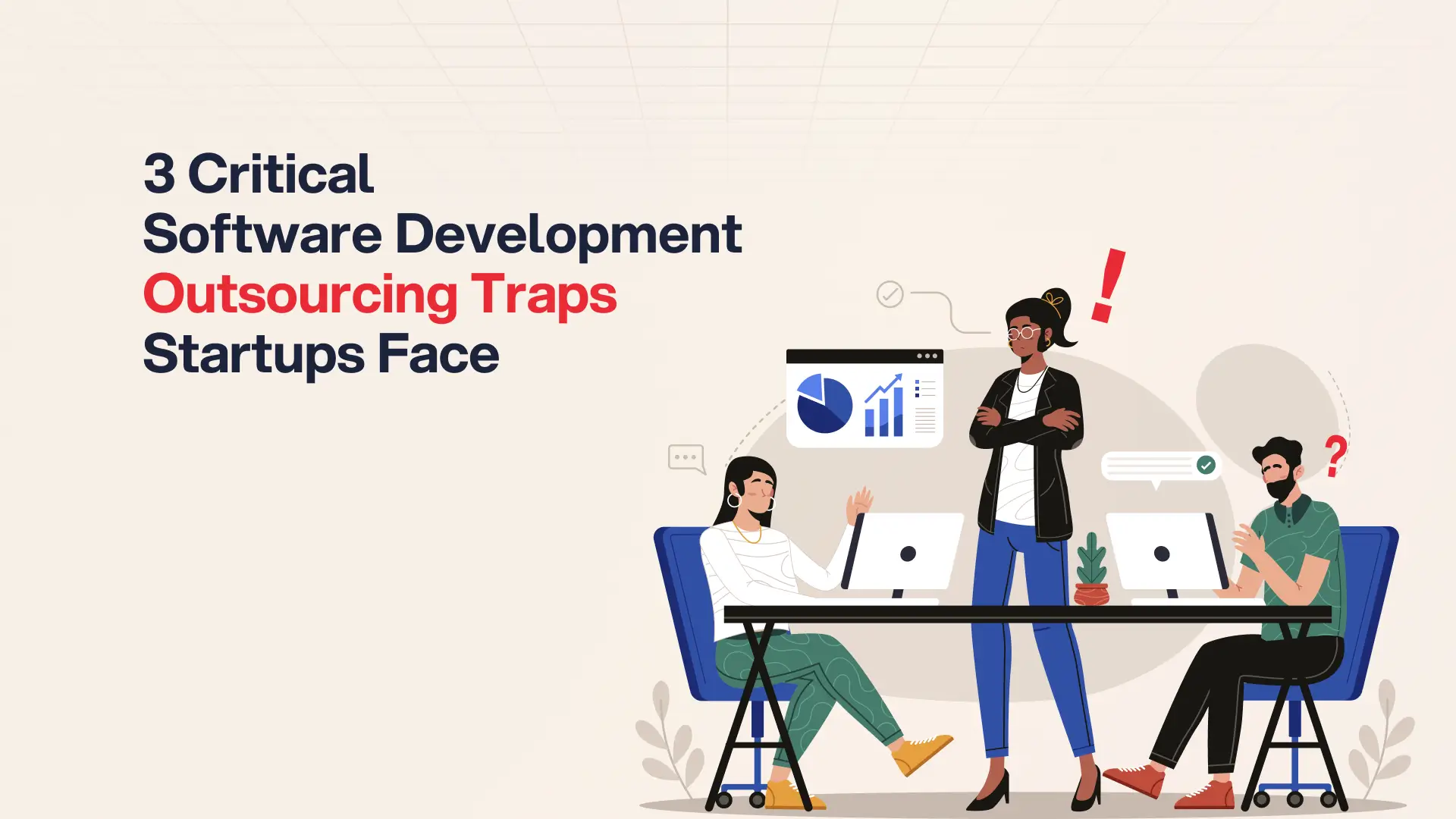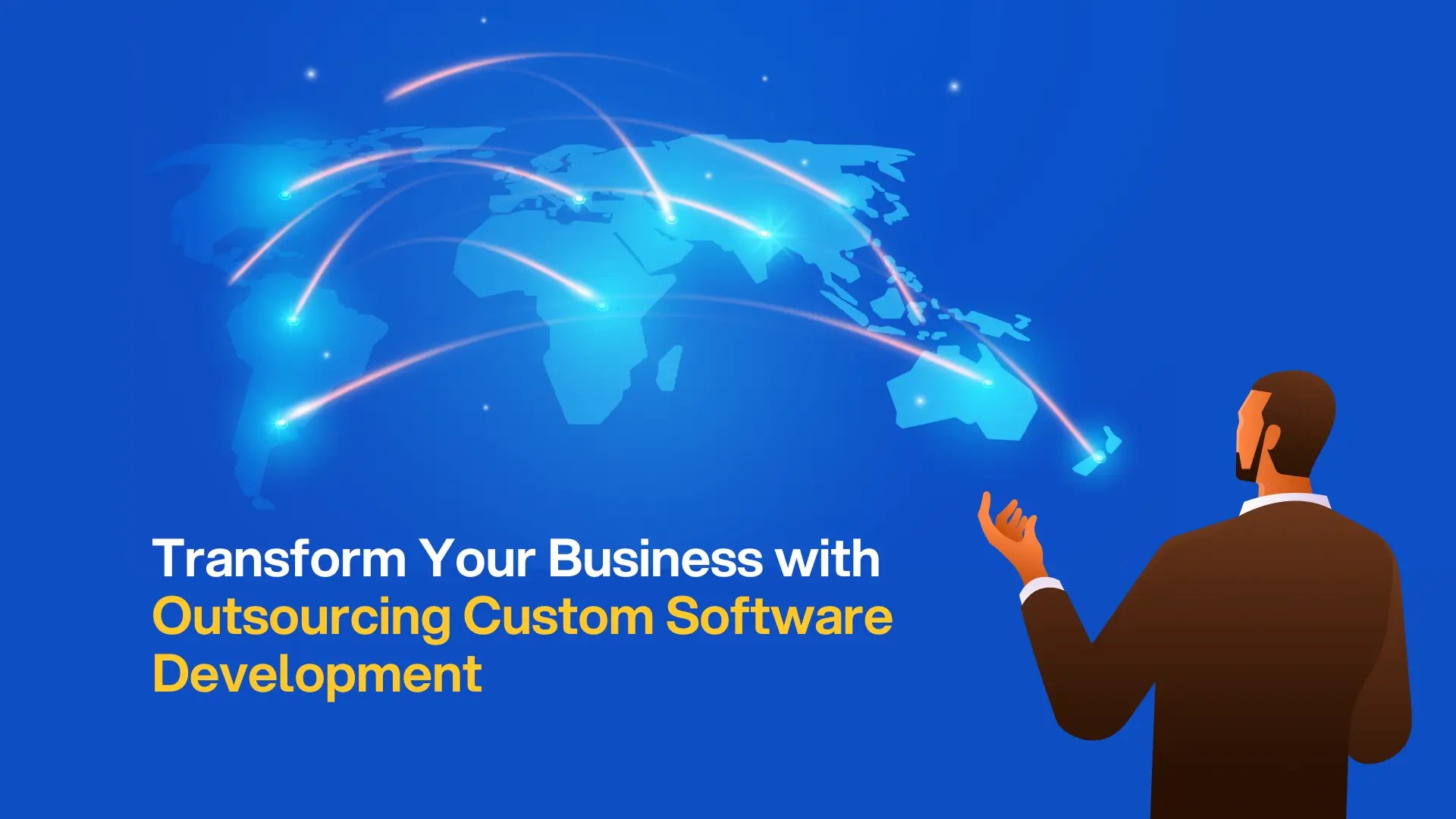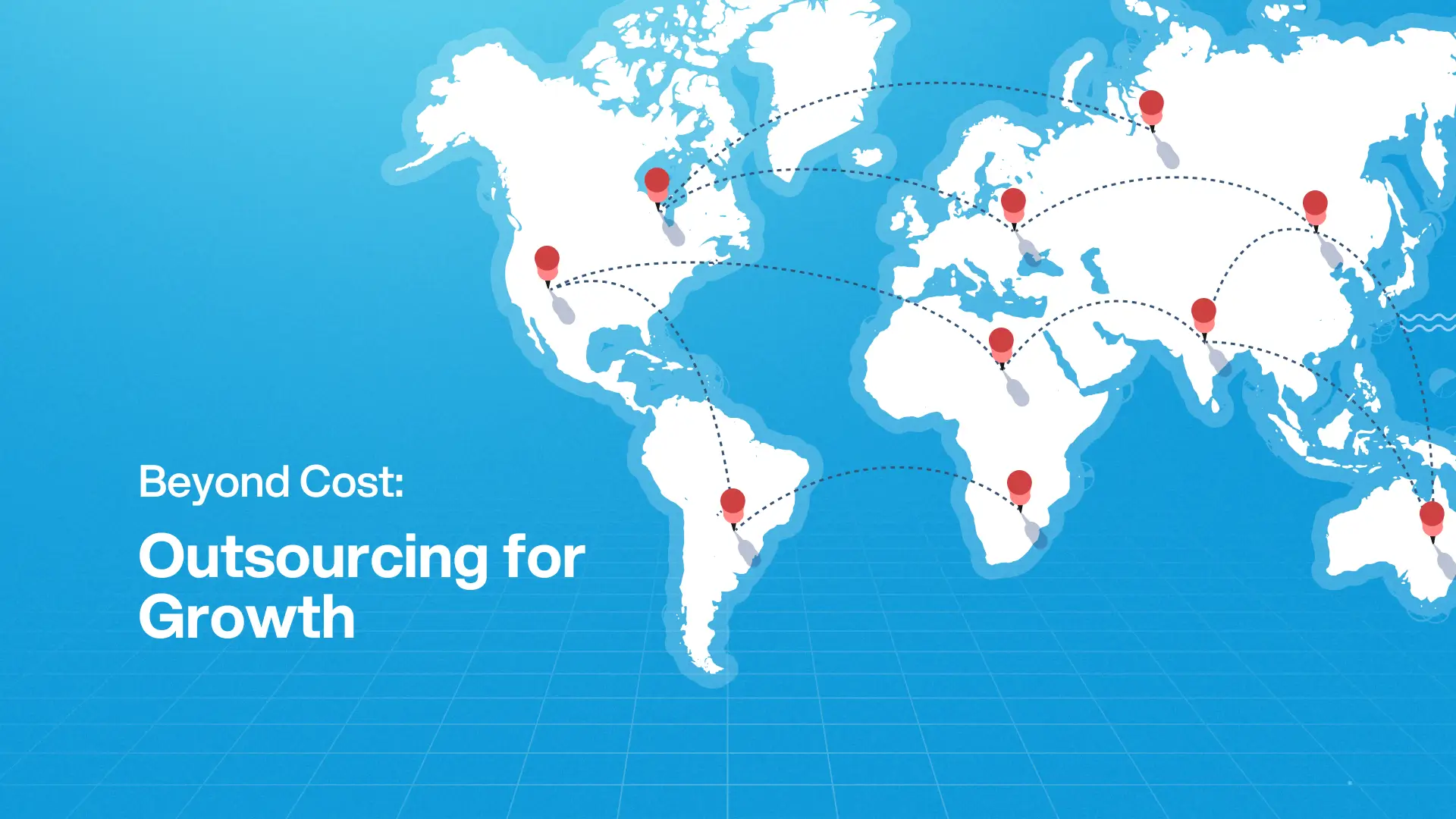Post Activity
 1262
1262
Table of Content
Share This Post
Table of Content
Outsourcing software development is widely recognized for providing companies with access to an expert talent pool, cost efficiency, and the opportunity for a faster time to market. However, it is more complex than handing out your project to the lowest bidding vendor. To make the best of the global expertise and adaptive delivery models, companies need to define their product goals clearly, choose the right vendor model, and take actions to mitigate potential setbacks.
This $564.22 billion global market is overwhelming to navigate. Understanding the basic structure, benefits, and drawbacks helps to make a more informed decision.
Strategic Advantages of Outsourcing Software Development
Best-case scenarios in outsourcing reduce costs by up to 60%. Furthermore, 80% of executives surveyed by Deloitte for a report have said that they are willing to increase their outsourcing budget based on the value they are receiving from the investment.
Here is a brief list of key benefits of outsourcing:
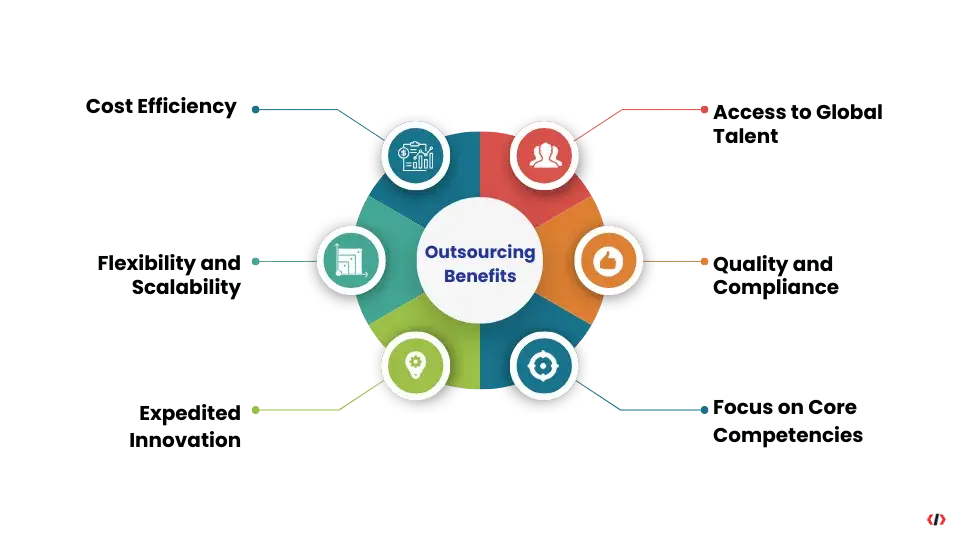
Cost Efficiency and Savings
Outsourcing reduces expenses related to hiring, benefits, and infrastructure, freeing up resources for innovation and higher-value activities.
To capture true ROI, outsourcing should be treated as a variable cost model. It is important to, negotiate transparent pricing structures, link payments to deliverables, and reinvest savings into R&D or market expansion.
Access to Global Talent
Outsourcing connects companies to a worldwide pool of skilled developers. This makes it possible to bridge local shortages and tap into niche expertise such as AI, machine learning, and cloud services.
To maximize this benefit, vendor teams must be aligned with the in-house tech stack and project goals. Conducting technical interviews, running trial projects, and confirming the partner’s ability to deliver on specialized capabilities before scaling yields better results.
Flexibility and Scalability
Outsourcing makes it easy to scale teams up or down depending on project needs. This elasticity shortens delivery cycles, supports high-growth phases, and outperforms fixed in-house structures.
To ensure scalability works in the company’s favor, choosing a partner with a proven bench of talent and strong onboarding practices goes a long way. On the other hand, insisting on clear ramp-up and ramp-down terms in the contract and reassessing the outsourcing strategy every 18–24 months helps with better planning.
Quality and Compliance
Outsourcing partners bring mature workflows, QA practices, and expertise in regulated industries such as healthcare and finance. This ensures GDPR and HIPAA compliance while reducing risks to intellectual property.
To protect the organization, the vendors should be required to demonstrate compliance certifications, run regular audits, and include IP protection clauses in contracts. It is essential to align quality standards through KPIs like defect density and sprint throughput.
Expedited Innovation
Working with external partners gives companies access to new technologies and practices. Outsourcing firms often have hands-on experience with DevOps automation, AI-assisted development, and cloud-native architectures.
To translate this into business value, prioritizing vendors with a strong innovation portfolio and investing in joint workshops or pilots are pivotal. In addition, insisting on a sprint zero to get a feel of how the vendor truly operates helps make a more educated decision.
Strategic Focus on Core Competencies
Delegating software development frees internal teams to focus on business-differentiating activities such as strategy, customer experience, and product innovation.
To make this work, mapping core vs. context activities before outsourcing helps to have a better structure in place. This secures companies’ competitive edge while outsourcing operational or specialized functions offers external expertise offers higher returns.
These benefits make outsourcing an attractive strategy. Nonetheless, it is important to recognize the potential challenges that can impact outcomes if not managed properly.
Potential Setbacks and Mitigation Strategies
Outsourcing software development has 6 drawbacks that companies should be aware of the following setbacks, so that it is ready with a mitigation strategy when facing any of these:
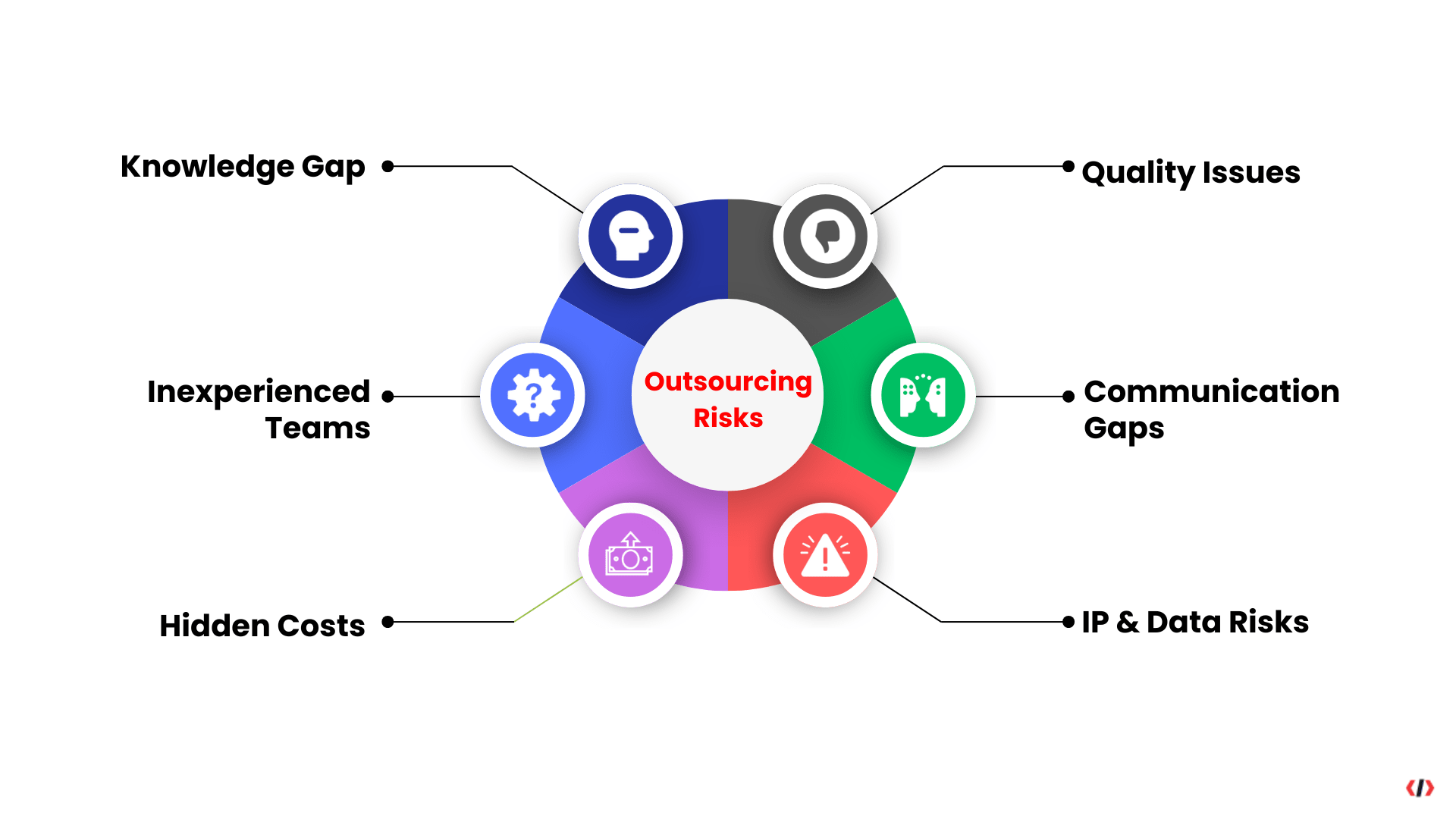
Loss of in-depth internal knowledge of the product
When projects are outsourced, the vendor team retains a deep understanding of the product. This may lead to your company not knowing how to properly operate or maintain the product after the vendor contract is over.
Mitigation: It is essential to have some in-house tech expertise. Maybe have an in-house CTO to look over the whole project.
Slump in quality
Oftentimes, based on the outsourcing model, there may be time-zone differences between the developers and the rest of the team. This results in a communication barrier.
Mitigation: It is important to ensure that the outsourced team is treated as an extension of the internal team. The outsourced team should be integrated into the company culture and aligned with the other relevant stakeholders for better performance. For example, the vendor team should have a clear understanding of the company’s objective, the product, and the value proposition of the product.
Inexperienced team
Outsourcing software development gives you access to the best developers across the globe. However, when focused only on cost saving, companies can overlook this advantage and go for the lowest bidder. This leads to getting inexperienced developers with little domain knowledge or industry expertise.
Mitigation: Overcoming this involves having a well-defined strategic goal for outsourcing. Ensure there is a good mix of senior, junior, and mid-tier developers.
Thinking of Outsourcing?
Access a wide range of outsourcing companies and find your best fit.
Communication barrier
When dealing with teams whose language, culture, and or communication style are very different from yours, it is easy to have miscommunication. Mix in the time zone differences, and outsourcing can be a recipe for disaster.
Mitigation: This can be mitigated in several ways. Proper documentation is key. Additionally, using tools like Jira, Asana to track tasks and epics; establishing structured communication protocols like daily standups and weekly sprint reviews; and having a project manager from the vendor team to ensure better communication.
Hidden Costs
While outsourcing promises savings, hidden costs such as onboarding delays, management overhead, scope creep, and licensing fees can erode ROI.
Mitigation: contracts should include transparent cost breakdowns and milestone-based payments. Assigning an internal outsourcing manager also helps track expenses.
Intellectual Property and Data Security Concerns
Sharing sensitive data like code, business logic, and customer data poses security risks. Furthermore, a lack of a proper contract may lead to legal disputes over code ownership.
Mitigation: Ensure the vendor is certified in ISO/IEC 27001 or SOC 2 Type II. Audit and monitor vendors and ask for compliance reports. Have IP ownership clauses, confidentiality agreements, and jurisdictional clarity in contracts. Use secure code repositories with role-based access (GitHub Enterprise, Bitbucket, GitLab). Apply encryption for data in transit and at rest.
A company’s ability to gain the benefits of outsourcing and limit setbacks depends largely on the model it selects. For that reason, identifying the model that best supports a project’s goals is critical.
Choosing the Right Outsourcing Models
Outsourcing software development models can be divided into 3 major categories based on location, team structure, and contract type. Which outsourcing model will suit a company’s needs depends on the company’s size, maturity, project needs, and more.
This article does not elaborate on each of the models, but here’s an overview of them:
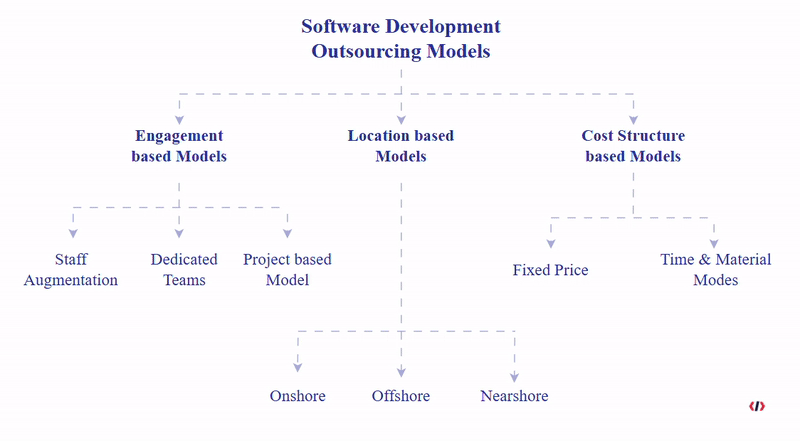
Engagement-based Outsourcing Models
Depending on the outsourced team’s dynamic with the company, there can be three types of outsourcing models.
i. Staff augmentation
It is also known as dev staff outsourcing or outstaffing. In such models, companies bring in a third-party provider to strengthen the existing in-house team. The company pays for the staff’s time (on an hourly or monthly basis) while the vendor company deals with the HR, payroll, benefits, and infrastructure aspects. Staff augmentation is great for adding short-term resources to the team. Especially to fill specific skill gaps or enhance skills.
ii. Dedicated team
Here, the vendor provides the company with a full technical team working on your requirements long-term. Unlife staff augmentation, the outsourcing company runs the team and ensures your goals are met. Many companies opt for it for it scalable, efficient, and focused nature. Such models require upfront onboarding, and for the best results, treat the team as an in-house extension
iii. Project-based Model
In project-based models, companies outsource an entire project to the outsourcing company. The vendor is responsible for everything from planning to product launch. Such outsourcing requires providing requirements up-front. Many organizations use it for MVPs, prototypes, and side projects as these have low management overhead and predictable costs.
Location-based Outsourcing Models
The outsourcing models can vary based on their time zone, culture, and geographical distance from your company’s country. There are four types of location-based outsourcing models:
i. Onshore Outsourcing
Refers to outsourcing to a company in the same country, not necessarily the same location. On the other hand, there’s onsite outsourcing where the vendor sends resources to go and work at the company’s premises. These two tend to be much expensive compared to other location-based outsourcing models. They are best for companies seeking maximum oversight, the same time zone, and a legal framework.
Ready to Build Your Team?
Let’s create together, innovate together, and achieve excellence together. Your vision, our team – the perfect match awaits.
ii. Offshore Outsourcing
On the other spectrum of location-based outsourcing models is offshore outsourcing. Here, the vendor team is located in a different country, often halfway across the globe. Limited time zone, cultural, and communication style overlap may lead to slower collaboration. However, offshore vendors often offer overlapping work hours with the outsourcing company to ensure better delivery. Most companies choose this model for cost efficiency and access to a larger talent pool.
iii. Nearshore Outsourcing
Neashore falls in between onshore and offshore. In such models, the company outsources software development efforts to a nearby country. Usually within 1 to 2 time zones. This model is best for companies that want overlapping work hours with their vendor.
Cost Structure-Based Outsourcing Models
Outsourcing can be majorly divided into two types based on how the vendor gets paid:
i. Fixed-priced Model
Here, there are predefined scopes, budgets, and a timeline before the project begins. The vendor delivers the software within those agreed boundaries, and payment is tied to milestones or the final delivery. It is best used for small or short-term projects like MVPs, proofs of concept, and pilot apps.
ii. Time and material Model
Suited for complex evolving projects, in this model, the company pays as per the actual time and resources (e.g., developers, project managers, testers, etc) the vendor allocated to the project. It is best for long-term initiatives where the scope of work is likely to evolve and the company is seeking that flexibility from its vendor. Best practices involve using agile methodologies for such projects for better oversight and product delivery.
Here is a decision matrix example to better explain the usage of different outsourcing models together:
Outsourcing Model Decision Framework
Since the success of each model depends heavily on the partner’s capabilities, the next step is understanding how to evaluate and select the right outsourcing vendor.
Choosing the Right Outsourcing Partner
A successful outsourcing strategy begins with cultural alignment between the partners. It is a strategic decision that impacts your company’s speed, security, and innovation trajectory. Alignment across business goals, cultural values, and operational expectations is what differentiates a vendor from a true partner.
It is important to keep these four aspects in mind when deploying your outsourcing strategy:
Evaluate Business Priorities
Identify where outsourcing supports your core competencies. Critical areas like software engineering, cloud migration, cybersecurity, or software testing often benefit from external specialists who can accelerate execution without compromising control.
Categorize opportunities by impact and urgency. And ask the following questions:
- Which functions slow down our core teams?
- Where do we lack specialized expertise or capacity to scale?
- What functions can be outsourced without impacting your IP or customer experience?
Research Providers Thoroughly
- Review portfolios, delivery history, and tools like Jira or Confluence for transparency.
- Use platforms like Enosis Outsourcing, Clutch, or GoodFirms for vetted reviews.
- Verify vendor expertise to ensure faster project delivery.
Prioritize Compliance and Industry Experience
- Select partners familiar with HIPAA, PCI-DSS, or GDPR to cut compliance risks.
- Choose vendors with industry experience to reduce onboarding time by 25%.
- Ensure robust IP protection through secure contracts.
Assess Cultural Fit and Communication
- Forbes highlights that testing collaboration via trial sprints reduces miscommunication risks by 25%.
- McKinsey stated that proper communication confirms 24/7 support and aligned time zones to avoid 20% project delays.
- Partner with vendors who adapt to your workflows and goals.
Here is a partner evaluation framework with what to look for and why it matters:
Vendor Selection Checklist
Find Your Perfect Software Outsourcing Partner
Unlock a world of trusted software outsourcing companies and elevate your business operations seamlessly.
Choosing the Right Pricing Strategy
Selecting an outsourcing model is only half the equation; the pricing strategy ultimately determines whether the engagement delivers sustained business value. While fixed-price and time & materials contracts set the foundation, executives must ensure pricing aligns with strategic goals, risk appetite, and long-term ROI.
Leading enterprises treat pricing as a governance exercise, not a rate comparison. CFOs should prepare:
- Cost–benefit analyses that account for onboarding, governance, integration, and potential rework—not just vendor fees.
- Revenue impact forecasts linking outsourcing spend to faster launches, market share growth, or reduced downtime.
- Scenario models to test how pricing structures perform under scope changes, compliance audits, or delivery delays.
To strengthen negotiations and financial control, consider these strategies:
- Milestone-Based Payments: Tie disbursements to verified deliverables or outcomes, reducing exposure to scope creep.
- Blended Rate Models: Use composite rates across senior, mid-level, and junior resources to optimize cost efficiency.
- Market Benchmarking: Leverage outsourcing databases and vendor comparison platforms (e.g., EnosisOutsourcing) to validate competitiveness before signing.
- Regular Audits & Renegotiations: Compare vendor rates to market data every 12–18 months to maintain fairness and improve leverage.
- Governance Alignment: Establish internal oversight with outsourcing managers, dashboards, and transparent reporting to track costs in real time.
By pairing the right outsourcing model with a data-driven pricing strategy, companies move beyond lowest-bid decisions to build a framework that balances cost, flexibility, and business outcomes.
Best Practices for Successful Outsourcing
A successful outsourcing engagement depends on the partner’s capabilities and also on how well your internal team aligns around goals, processes, and expectations.
Setting Clear Objectives and Expectations
- Define KPIs like code quality or sprint throughput, boosting delivery by 25% .
- Establish communication protocols to reduce miscommunication risks by 20%.
Building Strong Partnerships
- Treat vendors as strategic partners, scheduling regular reviews to improve outcomes.
- Invest in onboarding (mission, workflows, backlog) to enhance ownership.
- Include IP protection in contracts, cutting breach risks.
Strategy Tip: Invest in onboarding. Share your company’s mission, user personas, architecture diagrams, product roadmap, key workflows, and product backlog. It builds ownership from day one.
Transparency Tools
- Implement project management tools (e.g., Jira, Trello) for 30% better visibility.
- Use real-time dashboards to track progress, reducing delays by 15%.
- Require vendors to provide audit logs, ensuring accountability.
Prioritizing Continuous Improvement
- Assign a dedicated outsourcing manager to streamline decisions, improving efficiency by 20%.
- Align stakeholders on goals and ROI expectations to boost project success.
- Conduct quarterly reviews to maintain strategic focus.
Performance Tip: Co-create a performance review cadence (e.g., quarterly) to evaluate progress, address blockers, and recalibrate KPIs. This keeps your team agile and outcomes-focused.
The framework below outlines key action items, associated tools, and their business benefits:
Outsourcing Success Framework
Establishing best practices ensures outsourcing engagements are managed effectively in the present. Furthermore, to stay competitive, companies are adapting these emerging trends to stay ahead of the curve.
Emerging Trends in Outsourcing
Technologies are evolving, and market demands are shifting. As a result, outsourcing strategies are evolving to be based on innovation and long-term value. Staying ahead of these outsourcing trends ensures your strategy stays relevant and future-proof.
Increased Focus on Cybersecurity
Cybersecurity risk has become a critical consideration in outsourcing arrangements. According to IBM, the average cost of a data breach reached $4.45 million in 2023. This places cybersecurity among the top boardroom priorities. Executives are now holding outsourcing partners to the same security standards as internal teams.
Leading service providers:
- Embed security into the software development lifecycle through DevSecOps.
- Conduct regular vulnerability assessments.
- Maintain industry-recognized certifications such as ISO/IEC 27001 and SOC 2 Type II.
These capabilities make security a key part of the modern software development life cycle. The IBM case study shows that regular audits and SOC 2 compliance cut breach costs by 40%.
AI Integration and Cloud-Native Development
AI has changed how outsourcing partners deliver value. Tools like GitHub Copilot, AI-assisted code reviews, and test automation platforms are improving developer productivity and reducing time-to-release.
At the same time, providers with skills in cloud infrastructure, Kubernetes, and microservices now offer a strong foundation for modern software development services. Forward-thinking outsourcing partners now offer these capabilities as part of their standard delivery stack.
These upcoming practices reflect a broader shift in outsourcing from tactical execution to strategic enablement.
Final Thoughts
Outsourcing software development has moved far beyond cost reduction to become a strategic investment for growth and competitiveness. The companies that capture real value approach it through the 3C framework: choosing the right outsourcing model, choosing the right partner, and choosing the right pricing strategy.
When these three decisions are made with clarity and discipline, supported by well-defined product goals and proactive risk management, outsourcing shifts from a transactional cost exercise to a strategic lever that drives innovation, resilience, and long-term ROI.
Find Your Perfect Software Outsourcing Partner
Unlock a world of trusted software outsourcing companies and elevate your business operations seamlessly.

